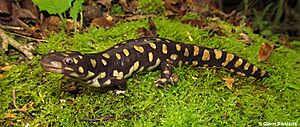Tiger salamander facts for kids
Quick facts for kids Tiger salamander |
|
|---|---|
 |
|
| Several in captivity | |
| Conservation status | |
| Scientific classification | |
| Genus: |
Ambystoma
|
| Species: |
tigrinum
|
| Synonyms | |
|
|
The tiger salamander (Ambystoma tigrinum) is a fascinating amphibian. It belongs to a group called mole salamanders. These creatures are some of the largest salamanders found on land in North America. They are known for their bright, tiger-like markings.
Contents
What Does a Tiger Salamander Look Like?
Tiger salamanders usually grow to be about 6 to 8 inches (15 to 20 cm) long. They can live for around 12 to 15 years. Their bodies have unique markings. These spots vary in color from brownish-yellow to greenish-yellow. The rest of their back is usually black or dark brown.
These salamanders have smooth bodies. They have special grooves along their sides called costal grooves. These grooves help them control moisture. They also have short snouts, thick necks, strong legs, and long tails.
Males and females look a bit different. Males are usually larger than females. They also have longer and higher tails.
Sometimes, if their water environment is just right, some salamanders don't change completely into adults. They keep their larval features, like gills, and stay in the water. This is called paedomorphosis.
What Do They Eat?
Tiger salamanders are carnivores, meaning they eat meat. Their diet mainly includes small insects, snails, slugs, frogs, and worms. Adult salamanders might even eat other smaller salamanders. They also hunt lizards, baby snakes, and newborn mice if they get the chance.
Where Do Tiger Salamanders Live?
Tiger salamanders can live in many different places. Their habitats range from forests with pine and leafy trees to open grassy fields. These amphibians are quite shy. They spend most of their lives hidden underground in burrows. This makes them hard to spot!
One important thing they need is loose soil for digging their burrows. After they change into adults, they often move to a new area. Females have been known to travel farther than males. Larger salamanders also tend to migrate longer distances.
Adult tiger salamanders mostly live on land. They usually only go back to the water to breed. They prefer breeding in wet areas like cattle ponds, temporary pools (called vernal pools), and flooded swamps. These wetlands are often chosen if they are large, deep, and surrounded by forests.
You can find this species most often along the Atlantic coast. This stretches from New York down to Florida. However, they are the most widespread salamander species in North America. Smaller groups can be found from one coast to the other.
Tiger salamanders found in the northern and eastern United States are thought to be native. This means they have lived there for a very long time. But those on the west coast might have been introduced by humans. They were sometimes used as fishing bait, which led to them mixing with local salamander types.
These salamanders are good signs of a healthy environment. They need good, moist soil to dig in. However, things like disturbed ponds, fish that don't belong there, and road construction can harm their populations each year.
Life Cycle and Reproduction
Like all mole salamanders, tiger salamanders are very loyal to where they were born. They will travel long distances to return to their birthplace for breeding. Some studies show they can travel up to 255 meters after breeding. This is likely them going back to their original homes.
A single tiger salamander has only about a 50% chance of breeding more than once in its life. In one study, male tiger salamanders started their breeding journeys in late October or November. Females began theirs from November through February. The best time for them to breed is in late winter to early spring. This is when the ground is warm enough and the water is thawed.
Mating Rituals
Males will gently nudge a female to start mating. Then, they place a special packet of sperm, called a spermatophore, on the bottom of the pond. Some clever males, called "sneaker males," might act like females. This helps them trick other females into taking their sperm packet without alerting rival males.
It seems that a salamander's size doesn't affect how successful it is at mating. However, females seem to prefer mates with longer tails. Males with longer bodies might also be better at competing with other males. But this doesn't always mean they will be more successful at mating.
About two days after mating, the female is ready to lay her eggs. She can lay 25 to 30 eggs in one group. She carefully attaches her eggs to twigs, grass, and leaves at the bottom of the pond. This helps keep them safe.
From Egg to Adult
The eggs usually hatch in about 12 to 15 days. The young salamanders then grow in the pond. It takes about three months for a tiger salamander to fully mature and leave the breeding pond. Larger young salamanders tend to travel just as far from the pond as adult females.
It has been difficult to breed large numbers of tiger salamanders in captivity. Scientists are still trying to figure out why.
The baby salamander, called a larva, lives entirely in the water. It has large external gills and a long fin on its tail. This looks a lot like the Mexican axolotl. Their legs develop quickly after hatching.
Some larvae, especially in temporary ponds or colder areas, will change into adults as soon as they can. These are known as small morph adults. Other larvae, especially in older ponds or warmer climates, might not change until they are fully grown. These large larvae are often called 'waterdogs'. They are sometimes used as fishing bait or kept as pets.
Some populations might not change into adults at all. They become able to reproduce while still in their larval form. These are called neotenes. This often happens when conditions on land are not good. Water-dwelling tiger salamanders prefer deeper water compared to other salamander species.
Health and Diseases
Tiger salamanders are quite strong themselves. However, they can carry and spread certain diseases. One is a fungus called Batrachochytrium dendrobatidis. This fungus is a big threat to many frog species around the world. It causes a disease called chytridiomycosis.
Tiger salamanders can also carry ranaviruses. These viruses can infect reptiles, amphibians, and fish. Using tiger salamander larvae as fishing bait seems to be a major way these viruses spread to wild animal groups. One ranavirus is even named the Ambystoma tigrinum virus (ATV). This specific ranavirus only affects other salamanders. It has not been found in fish or other amphibians. Sometimes, ranavirus infections can cause many tiger salamander larvae to die.
Family Members
The California tiger salamander (Ambystoma californiense), the barred tiger salamander (A. mavortium), and the plateau tiger salamander (A. velasci) were once thought to be just different types of A. tigrinum. But now, scientists consider them separate species. Genetic studies showed that the original A. tigrinum group needed to be split up. However, some mixing between these groups still happens.
The California tiger salamander is now listed as an endangered species by the government. This is mostly because they are losing their natural homes. Not many studies have been done on this specific species yet.
The axolotl is also a relative of the tiger salamander. Axolotls stay in their larval form for their entire lives. They keep most of their baby features. In nature, they never change into adults. But if scientists make them, they can change into a form very similar to the plateau tiger salamander. However, this is not natural for them and makes their lives much shorter. Recently, scientists found some tiger salamander DNA in axolotls kept in labs.
Tiger Salamanders in Society
On February 2, 2005, a politician named Bob Biggins suggested a new law. He wanted the tiger salamander to be the official state amphibian of Illinois. He also wanted the painted turtle to be the official state reptile. The governor, Rod Blagojevich, signed this bill into law on July 19, 2005.
Images for kids
See also
 In Spanish: Salamandra tigre para niños
In Spanish: Salamandra tigre para niños






